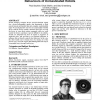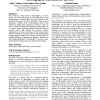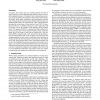192 search results - page 22 / 39 » Understanding Purposeful Human Motion |
HRI
2009
ACM
14 years 2 months ago
2009
ACM
Several emerging computer devices read bio-electrical signals (e.g., electro-corticographic signals, skin biopotential or facial muscle tension) and translate them into computer- ...
WSC
2008
13 years 10 months ago
2008
Semiconductor industry is a capital intensive and knowledge intensive industry, in which human resource management and human capital enhancement is increasingly important. To main...
JETAI
2000
13 years 7 months ago
2000
Human free will is a product of evolution and contributes to the success of the human animal. Useful robots will also require free will of a similar kind, and we will have to desi...
CHI
2009
ACM
14 years 2 months ago
2009
ACM
We review the current status of ethnography in systems design. We focus particularly on new approaches to and understandings of ethnography that have emerged as the computer has m...
APVIS
2009
13 years 8 months ago
2009
To analyze time-varying data sets, tracking features over time is often necessary to better understand the dynamic nature of the underlying physical process. Tracking 3D time-vary...



